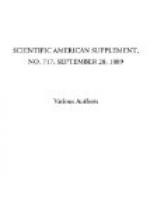As exemplifying to a certain extent the application of methodical research to an industrial problem, I propose to bring before you to-day an account of the work I have been engaged in for many years in relation to the procuring of new and abundant supplies of ammonia, and to investigations connected therewith.
Through the classic researches of Lawes and Gilbert, who proved, in opposition to no less an authority than Liebig, that ammonia is a most valuable manure which enables us not only to maintain, but to multiply, the yield of our fields, and thus to feed on the same area a much larger number of inhabitants, the immense importance of an abundant supply of ammonia, more particularly for the Old World, with its teeming population and worn-out soil, has been apparent to every one.
For many years Europe has paid to South America millions upon millions of pounds for ammonia in the shape of guano, and more recently, since the supply of guano practically ceased, for nitrate of soda, which effectually serves the same purpose as ammonia. During the past year South America exported 750,000 tons of nitrate, of which 650,000 went to Europe, representing a value of not less than 6,500,000l.
The problem of saving this immense expenditure to Europe, of making ourselves independent of a country so far away for the supply of a material upon which the prosperity of our agriculture—our most important industry—depends, by supplying this ammonia from sources at our own command, is certainly one of the most important which our science has to solve.
It is more than 100 years since Berthollet ascertained that ammonia consists of nitrogen and hydrogen, two elements which we have in great abundance at our command, and innumerable attempts have been made during this century to produce this valuable product by the direct combination of the elements, as well as by indirect means. It has been equally well known that we are in possession of three abundant sources of nitrogen:
(1.) In the shape of matter of animal origin.
(2.) In the shape of matter of vegetable origin.
(3.) In the atmosphere, which contains
no less than 79 per cent.
of uncombined nitrogen.
In olden times ammonia was principally obtained from animal matter, originally in Egypt by the distillation of camel dung, later on from urine, and from the distillation of bones and horn. The quantity so obtained was very small and the products very expensive. The introduction of coal gas for illumination gave us a considerable and constantly increasing supply of ammonia as a by-product of the gas manufacture, and until recently all practical efforts to increase our supply of ammonia were directed toward collecting and utilizing in the best possible manner the ammonia so obtained. The immense extension of the coal gas industry all over the world has in this way put us into possession of a very considerable amount of sulphate of ammonia,




